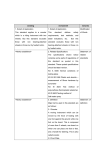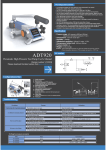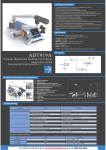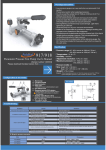Download INSTALLATION AND OPERATION MANUAL
Transcript
INSTALLATION AND OPERATION MANUAL Electronic pressure switch with protection against dry running ZD 15 Please read these manuals carefully before installation and application of the device. Both the installer and the end user must respect the manuals in detail, also concerning the valid local regulations, rules and laws. The device complies with the valid regulations the EU. The manufacturer assumes no liability for damages resulting from an incorrect application or an application under conditions different from those indicated on the type plate or within this manual. Cut off the power supply before opening the cover, if you want to remove the device or the switching cabinet. RANGE OF APPLICATION AND SERVICES Device for automatic control of electronic pumps in water units: • • • • • • Replaces the traditional system with expansion tank Switches the pump on or off, depending on opening or closing of the extraction points Keeps the pressure constant during the extraction Switches the pump off is case of water deficiency and ensures a protection against dry running Prevents hydraulic shock effects Requires no maintenance TECHNICAL DATA Voltage, single-phase Permissible voltage fluctuations Frequency Current rating Maximum output 230 V +/-10% 50-60 Hz 16 (6) A 1.1 kW (1.5 HP) Protection class Device Maximum operating pressure Maximum operating temperature External thread IP 55 ZD 15 8 bar (0.8 MPa) 65 °C G1" AG Non-adjustable standard start-up pressure between min. 1.5 bar and max. 2 bar. INSTALLATION (fig. 1 and 2) Attention: Before installation, ensure that the technical characteristics of the device, the pump and the unit are compatible. The pressure of then pump must amount to minimum 3.5 bar (0.35 MPa) and maximum 8 bar (0.8 MPa). The water column between the device and the highest extraction point must not exceed 15 m. If the pressure of the pump does not reach the above-mentioned values, the pump blocks or does not switch-off. The pump starts but does not switch-on or it does not switch-off if the height of the water column exceeds the abovementioned values. In order to eliminate this disturbance, install the device at a higher position. The device may be directly installed onto the pump or between the pump and the first extraction point (fig. 1). Install a pressure reducer between the pump and the device if the inlet pressure at the device exceeds 8 bar (0.8 MPa). No extraction point must be installed between the pump and the device (fig. 1). The device must be installed in such a manner that the arrows indicating the flow direction point upwards (fig. 1/A). It is recommended to install a ball valve and a manometer at the outlet of the device, in order to check the functionality of the pump and the device when they are separated from the unit using the valve and in order to determine the actual discharge height of the pump using the manometer. The output of the device should be connected to the pump using a flexible hose (fig. 1/B). Before commissioning the device, make sure the pump is properly bled. POWER CONNECTION (fig. 4) The device may be connected to mains by qualified staff only and in accordance with the valid legal requirements. An all-phase switch with a terminal distance of minimum 3 mm must always be connected head of the device. One-phase pumps (230 V) with a motor output of up to 1.1 kW (1.5 HP) (fig. 4/A) may be connected directly to the device, while one-phase pumps with an output of more than 1.1 kW (1.5 HP) (fig. 4/B) must connected via a contactor to the device. Check the mains voltage at the data indicated on the type plate of the pump motor. • Connect the electrical power as indicated in the graphs of fig. 4. • Use cables of type HOS or H07 with a cross section of 3x1 mm2. • Make sure the device is connected to the earthing system. COMMISSIONING AND OPERATION (fig. 3) The green lamp “power on” on the front side of the device shows that voltage is connected, while the yellow lamp “pump on” shows that the pump in operation. If the device will be connected to the mains, the green and the yellow lamp light up. The latter shows that the pump is started (fig. 3/A); it rests in operation for some seconds, in order that the unit may be pressured. If this time should not suffice, push and hold the red button “restart” and wait until water leaves from an opened extraction point. After closing the extraction point, the device deactivated the pump and rests in stand-by mode; in doing so, the green lamp remains switched-on and the device is ready to execute all further command and control processes completely independent (fig. 3/B). When opening an extraction point, the device activates the pump; it rests in operation until the extraction point is closed again (fig. 3/A). After closing the extraction point, the device recovers the maximum pressure in the unit, switches the pump off and changes again to stand-by mode (fig. 3/B). If there is a water deficiency during the intake process, the device switches the pump (fig. 3/C) off in order to protect it against dry running. As soon as the disturbance which caused the blockage is removed, it is sufficient to push the red “restart” button in order to retake the normal operation. In case of a temporary disturbance of the power supply, the device starts again automatically as soon as the power is reconnected. DISTURBANCES CHIEF CAUSE • The pump does not start. • The pump does not switch-on. • The pump operates with disruptions. • The pump does not switch-off. • The pump is blocked. Faulty power supply. The water column is too high. Water removal of the unit is lower than the minimum flow. Loss of water in the unit is higher than the minimum flow. Intake difficulties. A defective switching cabinet may be replaced without removal of the device. The switching cabinet is replaceable and can be delivered on request. Further disturbances and causes different to the above-mentioned may be prevented or removed by carefully checking the characteristics of the device, the pump and the unit considering the instructions in the section on installation. FIGURES Attention! The pressure switch may only be assembled in vertical position (arrow points upwards) Direct connection to one-phase 230 V motors with a maximum power input of 1.1 kW. Connection via a contactor to one-phase 230 V motors with a power input of more than 1.1 kW.







